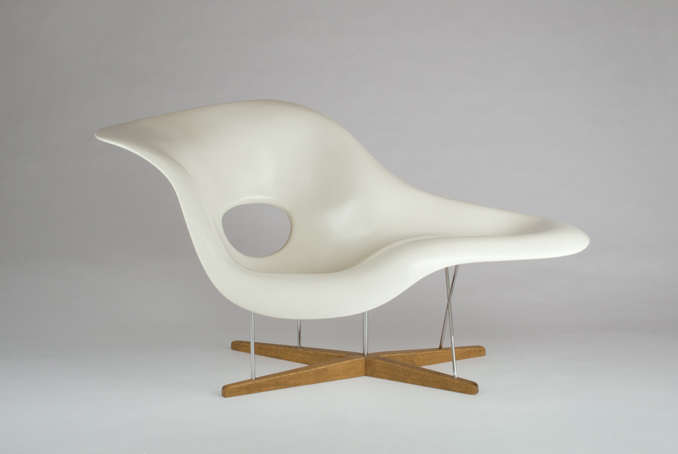
La Chaise (1948 (1996, this example))
Charles and Ray Eames
This was the first Eames molded plastic chair. It was created as one of the Eames Office entries in MOMA's Low Cost Furniture Competition of 1948. Its name, La Chaise, is a double entendre, a reference to its function and also to the work of artist Gaston LaChaise, whose sculpture Floating Nude was imagined as fitting perfectly on this shapely form, and whose round volumes are reminiscent of this chair. When submitted to MOMA, this chair was described with the following words, written by Ray Eames: "CONVERSATION, REST & PLAY: Gondola, confortable, Duchesse, Psyche, Kangaroo: are some of the names of the past for a type of seating that fills a difficult-to-define need of the time." MOMA awarded the Eames molded plastic chair group with Second Place, and La Chaise received an Honorable Mention.
Plastic, steel, wood 34 1/4 x 59 x 35 1/2 in
Collection J. F. Chen. Photograph by Grant Taylor © Eames Office LLC.
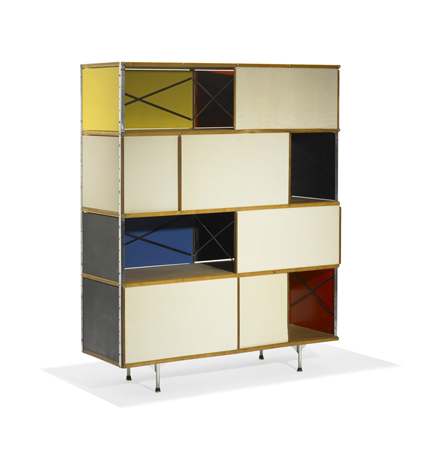
ESU 400-C (1952)
Charles and Ray Eames
The second edition of the Eames Storage Units represented an improvement and refinement of the original ESUs, to give greater service and performance to the customer. This particular unit has the maximum amount of enclosed space in the ESU group—thirty-two linear feet—and it was recommended for clothing or linens.
Wood, plastic laminate, white glass cloth laminate, steel 58 5/8 x 47 x 16 in
Collection J. F. Chen. Photograph by Grant Taylor © Eames Office LLC.
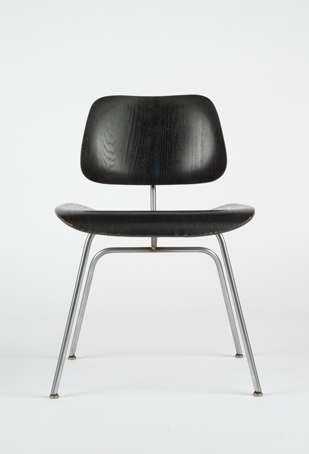
DCM (1946)
Charles and Ray Eames
Originally introduced in 1946, this classic Eames chair was offered in five different finishes, all revealed "honestly." As Charles and Ray Eames would say, "What's wood is wood." The black is not paint; it is an aniline dye, which does not obscure the wood grain.
Wood, steel, rubber 29 1/4 x 19 1/2 x 21 1/4 in
Collection J. F. Chen. Photograph by Grant Taylor © Eames Office LLC.

PSC-1 (1954)
Charles and Ray Eames
Plastic, Naugahyde, aluminum, steel, rubber 32 1/4 x 18 1/2 x 22 in
Collection J. F. Chen. Photograph by Grant Taylor © Eames Office LLC.
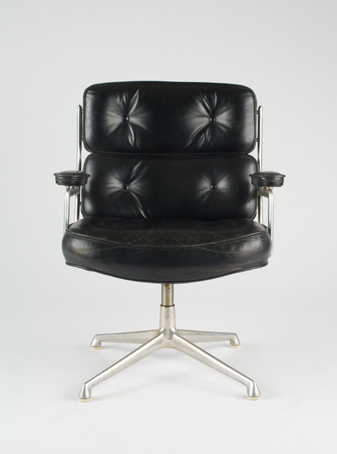
Eames Executive Chair 675 (1960)
Charles and Ray Eames
A padded leather chair, which was eventually manufactured and distributed to the general public by Herman Miller as "Executive Seating." was originally designed for the Eames-designed Time-Life Building lobbies. The chair was smaller than the 670 Lounge Chair, which could also be used as a conference chair.
Leather, foam, aluminum, wood 29 1/2 x 28 3/4 x 29 1/4 in
Collection J. F. Chen. Photograph by Grant Taylor © Eames Office LLC.

Lounge Chair 670 (1956)
Charles and Ray Eames
According to Charles Eames, “Another thing we came to realize in our search for this kind of comfort is that feathers and down are pretty good materials. Like few others they give one the feeling of settling in and when you get up, feathers and down do not instantly pop back into place as though you had never been there. The leather cushions do have built-in wrinkles to start with, but that is a clue that spells comfort to come, like the warm receptive look of a well-used first baseman’s mitt.”
Wood, steel, leather, aluminum 29 1/2 x 28 3/4 x 29 1/4 in
Collection J. F. Chen. Photograph by Grant Taylor © Eames Office LLC.
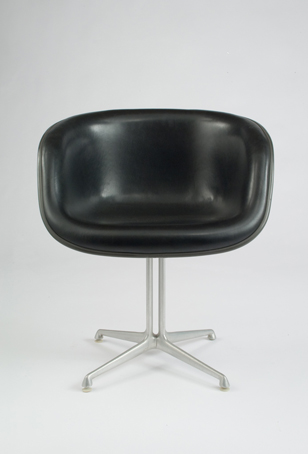
1730-1 aka "La Fonda" Arm Chair (1961)
Charles and Ray Eames
This and a related chair in this exhibition, the 1700-1, were developed in response to a request from Eames friend Alexander Girard for a dining chair with a low back profile, that would not extend about the tops of tables in La Fonda, his restaurant. The Eameses took this opportunity to redevelop their molded plastic shells, with lower back profiles, and also, to improve upon their bases. The "La Fonda" base is one hundred percent solid cast aluminum, and was simpler to manufacture and assemble than other similar Eames chair bases, which were made in three different stages of three different materials.
Plastic, Naugahyde, aluminum, rubber 29 1/2 x 25 x 22 in
Collection J. F. Chen. Photograph by Grant Taylor © Eames Office LLC.

DKR-2 (1950)
Charles and Ray Eames
Although collectors have long called this upholstery option the "bikini pad," it was not designed for its appearance. Rather, it represents a lighter weight and, therefore, a lower cost (less materials used) alternative to the one piece pad.
Steel, Naugahyde 32 3/4 x 19 x 21 1/4 in
Collection J. F. Chen. Photograph by Grant Taylor © Eames Office LLC
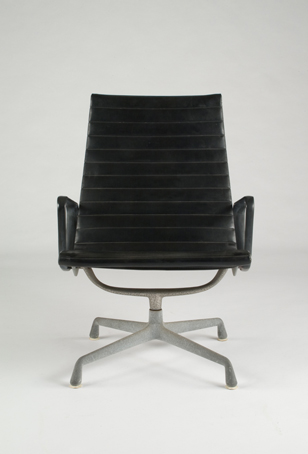
Eames Aluminum Group Lounge Arm Chair EA 115 (with Eames Universal Base) (1958)
Charles and Ray Eames
This chair comes equipped with the Eames universal base, first offered to the public in 1968; it is the final evolution in cast aluminum bases introduced by the Eames Office.
Aluminum, Naugahyde 35 1/4 x 25 1/2 x 27 1/4 in
Collection J. F. Chen. Photograph by Grant Taylor © Eames Office LLC
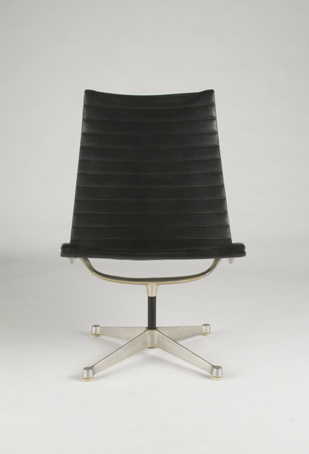
Eames Aluminum Group Lounge Chair 681 (1971)
Charles and Ray Eames
This is representative of the Eames aluminum group, a versatile group of chairs that represent an innovation in upholstery technique: pads of Naugahyde are held in tension between frames of polished aluminum. These lightweight chairs are rugged enough to serve handsomely indoors or outdoors, as well as in the home, the office, lobby, or reception area.
Naugahyde, aluminum, steel 35 1/4 x 22 x 27 1/4 in
Private collection. Photograph by Grant Taylor © Eames Office LLC.
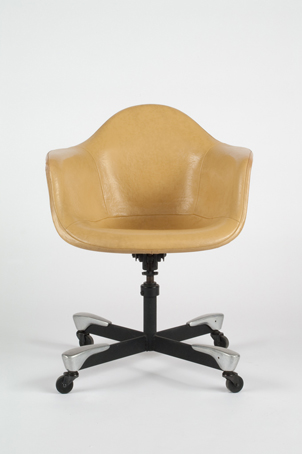
DAT-1 (1953)
Charles and Ray Eames
This chair has the earliest tilt-swivel base with casters developed by the Eames Office. With continual efforts, they eventually developed five different cast bases for their chairs, each one an advance over the one before. The development began with this chair, with a steel base, and applied cast aluminum caps. Later bases were made out of one hundred percent cast aluminum, as they developed greater facility with this material.
Plastic, Naugahyde, steel, aluminum, steel 34 x 24 7/8 x 23 in
Collection J. F. Chen. Photograph by Grant Taylor © Eames Office LLC.
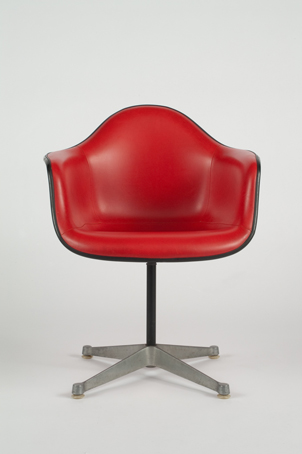
PAC-1 (1971)
Charles and Ray Eames
In 1971 the Eames Office used new technology to improve on various features: they replaced the applied rubber shock mounts with loose washers, by incorporating screws into the shells, and they switched from attached one piece foam pads to the "foamed in place" method. These two changes meant that Herman Miller could keep their costs in check, a benefit they passed along to consumers in a time of inflating prices fo rmany other consumer products.
Plastic, Naugahyde, aluminum, steel 32 1/4 x 24 7/8 x 24 in
Collection J. F. Chen. Photograph by Grant Taylor © Eames Office LLC.

MOMA Organic Design Competition High Back Lounge Chair (1941)
Charles and Ray Eames
Charles Eames and Eero Saarinen won First Place in the 1941 MOMA Organic Design Competition with this and related chairs. This example is upholstered with woven fabric by Marli Ehrlman, who won First Prize in fabrics in the same competition.
Wood, cloth, rubber, steel (later addition) 42 1/8 x 33 1/2 x 31 in
Collection J. F. Chen. Photograph by Grant Taylor © Eames Office LLC.
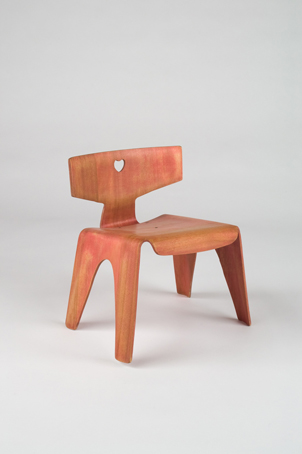
Child's Chair (1945)
Charles and Ray Eames
This child's chair was the first Eames chair to be successfully mass produced. Unfortunately, it was ahead of its time, and after an initial run of 5,000 chairs, production was halted. There was no viable market for children's furniture at the time of its introduction, and for many years thereafter. While some modernist purists criticized the "heart"-shaped design in the back, it is actuality functional in two ways: it is a signal of playfulness, which is very appropriate for its intended users, and it is also a handy way to carry the chair.
Wood 14 1/2 x 13 3/4 x 11 in
Collection J. F. Chen. Photograph by Grant Taylor © Eames Office LLC.

Kleinhans Hall Chair (1939)
Charles and Ray Eames
This chair was one of two types of lobby chairs designed by Charles Eames and Eero Saarinen for the Kleinhans Music Hall, home of the Buffalo Philharmonic Orchestra, which was built in the late 1930s and opened October 1940. The building was designed by Eliel Saarinen with his son, Eero Saarinen, and "was recognized as one of the greatest concert halls ever built in the United States." It was declared a National Historic Landmark in 1989.
Wood, cloth, rubber 30 x 19 x 21 in
Collection J. F. Chen. Photograph by Grant Taylor © Eames Office LLC.

DCM (1960)
Charles and Ray Eames
Detail of the rosewood grain on the Eames DCM. This photograph shows how the Eameses "honest" use of wood gave their chairs an unobtrusive yet naturally decorative appearance.
Wood, steel rubber
Collection J. F. Chen. Photograph by Grant Taylor © Eames Office LLC.
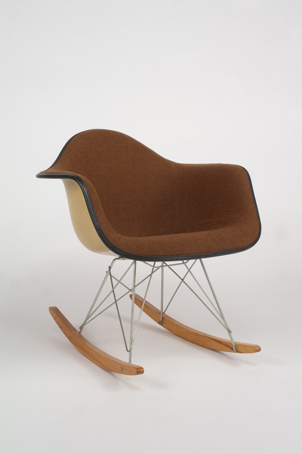
RAR-1 (1979)
Charles and Ray Eames
The original rocker version of the armchair was not offered to the public after 1968, but until 1984 an Eames rocker was gifted to every Herman Miller employee who had a baby. This is a "baby" rocker, and it retains its original brass plate on the back, inscribed with a baby's name and birthdate.
Plastic, steel, wood, rubber 24 x 24 7/8 x 27 in
Collection J. F. Chen. Photograph by Grant Taylor © Eames Office LLC.
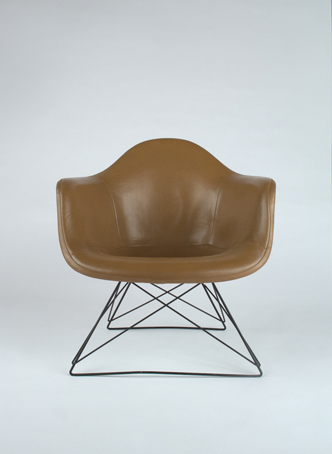
LAR-1 (1953)
Charles and Ray Eames
Two years after the Eames molded plastic chairs were first put on the market, the Eames Office developed a one-piece upholstered pad for what they sometimes called their "Low Low" chair (because of its low seat height), for lounge seating. The upholstered foam rubber pad, covered with Naugahyde, adds resilience.
Plastic, Naugahyde, steel, rubber 24 1/4 x 24 7/8 x 24 1/2 in
Collection J. F. Chen. Photograph by Grant Taylor © Eames Office LLC.






































